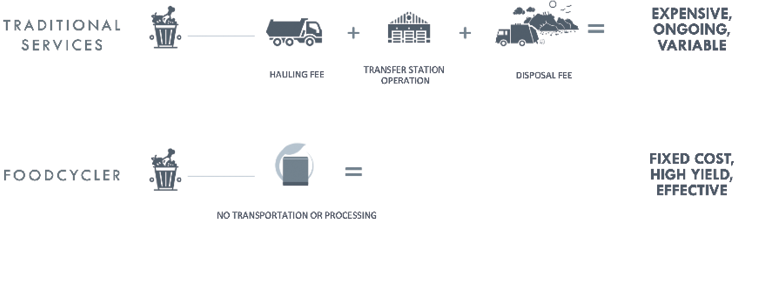The District of Tumbler Ridge will be bringing in up to 200 FoodCyclers as part of a pilot program to see how well the system works here.
The FoodCycler is a device that grinds and dries out food waste—from vegetable peels to chicken bones—and turns it into a biomass product that can be used as a soil additive or, if compressed, as pellets for home heating. According to Jacob Hanlon, who coordinates the Municipal Program for FoodCycle Science, and who presented to council at the April 3 council meeting, five litres of food waste becomes 200 g of this nutrient rich product.
The company has a commercial program, where the devices are sold direct to consumers for hundreds of dollars, but they also work directly with municipalities to get the FoodCycler into the hands of community members.
“Our municipal solutions help many small rural remote and northern communities keep food waste out of their landfills,” says Hanlon. “We’re currently working with 73 Canadian municipalities across seven provinces and territories from Nelson in British Columbia up to Hay River in the Northwest Territories, as well as several communities throughout Alberta, Manitoba, Ontario, and Quebec.”
He says one of the common threads with these communities is they struggle with food waste management, or are not in a position to set up a food waste collection program. “The problem with food waste is that it is avoidable,” says Hanlon. “It accounts for a large portion of our household waste, often a majority. And it’s made up of mostly liquid which is heavy and freezes in the wintertime. On top of that, when you put food waste in the landfill, it’s responsible for generating harmful greenhouse gases.”
All this means that food waste has a big impact on municipalities. “One of the impacts is that since food waste makes up such a large portion of our waste stream, it’s causing our landfills to fill up quickly.”
Operating a landfill (or in the case of Tumbler Ridge a transfer station) is costly, says Hanlon, and municipalities want to find ways to extend the lifespan.
But, he says, there is another problem, which is environmental. “When organic waste is in a landfill and it’s breaking down, it’s producing methane gas, which is many times more harmful than CO2,” “To put that into perspective, taking one tonne of food waste out of the waste stream is the equivalent of taking one car off the road for an entire year.”
Finally, he says, food waste in garbage cans is an attractant for wild animals. Removing food waste from the garbage eliminates these issues and reduces the overall weight and volume of the trash. “This can save on hauling and disposal fees, save space in the landfill, and it can save residents hassle getting rid of any excess that they might face.”
One of the most common solutions is the green bin program. These are common in big cities with a high population density, but for smaller communities, it is cost prohibitive.
In a recent report to council, Jason Bradley, Director of Operations and Infrastructure said that to add in another run, a second truck would need to be added to the District’s fleet, at a one-time cost of $380,000. (In that case, he was talking about a second run for picking up garbage, but would apply equally for a truck to pick up food waste.)

In addition, the District would need to hire someone to drive the truck and manage the space, for an additional $100,000 per year.
But, says Hanlon, the FoodCycler eliminates all that. Instead of the District having to pay someone to pick up the food waste, pay for the fuel for the vehicle and a new facility, the food waste would be completely removed from the solid waste stream. People could simply toss the dried remains into their garden. Or drop it off at the Community Garden.
He says that composting is a great solution, but it isn’t feasible in the north, especially in bear country.
The FoodCycler, he says, is about the size of a bread machine and takes most—though not all—food waste. “You push a button, and after about a four to eight hour cycle, what you have is a dry, sterile, odorless and nutrient rich soil amendment that comes out. The machine can be used anywhere that has a plug. Most people keep it in their kitchen, their basement, or even in a heated garage, and the machines will process on average between one and three kilograms of food waste per cycle.”
He says the cost for the electricity is about the same as is drawn by a computer that is left on for four to eight hours.
The company has two products, one that has a 2.5 litre bucket and one that has a five litre bucket. “We find that residents in our program sometimes prefer the larger bucket size in the unit if they have a larger family or they have a lot of food waste, though each unit is roughly the same size in terms of counter top space.” It’s up to the municipality to choose which unit they would like. Some order a mix and offer the choice to their residents.
He says the FoodCycler is actually a net-negative carbon solution. “The same can’t be said for waste and recycling collection services which would rely on a large fleet of carbon emitting vehicles. When we look at an economic impact, our solution offers a return on investment by significantly reducing the District’s waste management costs. You’re looking at savings of upwards of 100 to 150 dollars per tonne when you compare it to the traditional methods that involve hauling and disposal.”
He says in his experience, residents are very interested in being part of the solution. “They want to try new things, they want options, and they want their government to bring these things to their community. With the FoodCycler, you get to bring something innovative and tangible to your residents. They don’t need to live in a big city to be able to divert organics. We believe that food waste diversion should be available to all Canadians no matter where they live. And with the FoodCycler, what we’re doing is—no pun intended—we’re focusing on that low hanging fruit. Because food waste accounts for such a large portion of our household waste, it’s the single most impactful strategy to achieving any kind of diversion targets that you may have and may have coming in the future.”
By running the program through the District, he says, residents would be able to get the FoodCyclers at a “heavily subsidized price.”
People in the initial pilot program, he says, would purchase a FoodCycler at the subsidized rate from the municipality. “They would use the unit and track the number of cycles per week. And then at the end of the 12 weeks, they had to keep the food cycler, fill out a brief survey so that we can evaluate the program success. Then we present these results back to the District in a final report or a feasibility study to help with any future waste management decision-making.”
Hanlon says the federal grant reduces the price of each unit by 50 percent. “We then ask the municipality to subsidize by $100 per household or per unit. This allows the residents to have access to these solutions at the lowest price possible. And then after the 12 week pilot program, the unit is theirs to keep.”
He recommends having 100 households in the pilot program, which would cost the municipality $10,000. But when council discussed the possible program, they were interested in making it even bigger. “This is a really exciting project for our community,” says Councillor Noksana. “I don’t know if anyone has tried a backyard compost, but it is not super successful in Tumbler Ridge. You do sometimes get animals coming in and we have a really short warm season, so this is a great way to divert waste.”
Councillor Gulick says she loves the program as well. In fact, she is so keen on the idea, she suggests ordering more than 100, to keep down the cost of shipping. She expects many people in the community will be interested, and wants anyone who is interested to be able to get one. “I think that it’s pretty cool. I appreciate Ms Finnegan bringing in her unit so we could actually get a look at one. There was nothing in this I was hesitant about after hearing the presentation.”
Mayor Krakowka agrees that many people in town are going to be interested in the devices and suggests the community set a limit based on the number of people who pre-order, rather than 100. “That way if the community does support it and there’s 200 people who want it, we’re only ordering at one time and obviously it’ll help with our shipping.”
Councillor Dusseault agrees that this is probably going to be popular. “I just want to reiterate what everybody else is saying about this program. I think it’s really great and my only question is when can I get one?”
Councillor Hofman points out that this is a pilot program. “There’s nothing to stop us from ordering another hundred next year or have an open program or however we want to do this. I am gung-ho. I think this is a great idea and I think it’ll work but I don’t know. I think we are going to need to have some feedback on ‘did we have less waste actually going through the town’. We need to determine whether this is a good value for the town. I would be open to subsidizing to a degree, but I think we should know if this is actually worth it for the town. I am very hopeful if it is a decrease of 300 kilograms-ish per household going to the transfer station. I think we should see it in the transfer fees. We should get that feedback before we go gung-ho and order 500.”
In the end, Council decided on a pilot program of up to 200, based on the number of pre-orders.
After all the subsidies and discounts, the 2.5 litre unit would cost $150, while the larger 5 litre unit would cost $300. A charcoal filter, which should last three to six months, costs $20. Demo units will be available to look at and to ask questions about at the Let’s Talk meeting on April 19.
Trent is the publisher of Tumbler RidgeLines.

